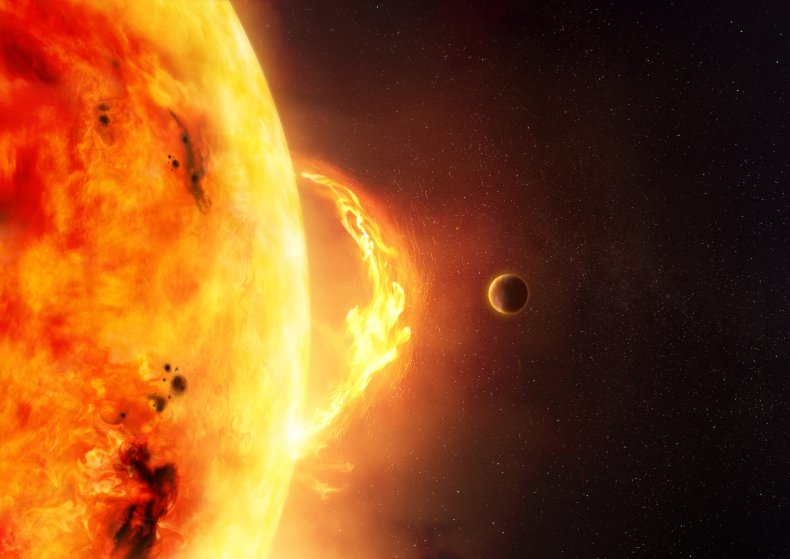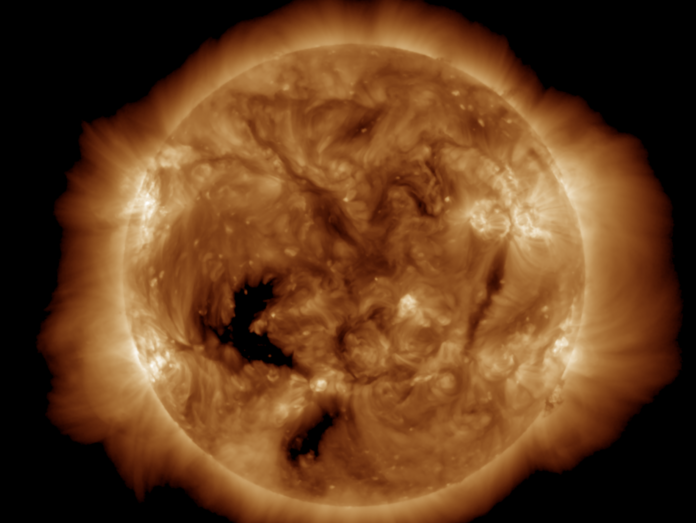A huge plume of solar plasma was spat out of the sun on Thursday and could hit the Earth Sunday, affecting our magnetic field and atmosphere.
This coronal mass ejection (CME) was shot out because of an erupting filament of magnetism in the sun’s southern hemisphere, which sent a cloud of plasma soaring in our direction.
“The CMEs from the filament eruption that began around 17/1530 UTC near Region 3309 were modeled and determined to be mostly ahead and south of Earth’s orbit. However, model results indicated a glancing blow is possible late on 21 May that would cause additional enhancements,” the National Oceanic and Atmospheric Administration (NOAA) said in a three-day geomagnetic forecast.
NOAA Space Weather Prediction Center
CMEs result when active areas of the sun’s surface where the magnetic fields are especially strong suddenly realign, spewing forth huge amounts of solar material with a strong magnetic field.
These CMEs then fly through space at immense speeds, up to around 6.7 million mph, arriving at Earth within a few days.
Martin Connors, a professor of space science and physics at Canada’s Athabasca University, previously told Newsweek: “The solar wind normally flows past at 300 to 700 [kilometers per second]—that is about a million miles per hour—with up to 10 particles per cubic centimeter….There is also a very small magnetic field in the solar wind, far smaller than what turns compasses at the surface of Earth.”

ISTOCK / GETTY IMAGES PLUS
When CMEs collide with the Earth, as this one might, they can cause geomagnetic storms, leading to beautiful auroras across the globe. Occasionally, they can have an impact on technology.
“A geomagnetic storm is the alteration of the Earth’s magnetic environment. This means when the magnetic fields that usually surround our Earth start to be distorted,” Daniel Brown, an associate professor in astronomy and science communication at the U.K.’s Nottingham Trent University, previously told Newsweek.
Geomagnetic storms vary in strength, depending on the properties of the CME, and therefore can have a variety of impacts on the planet.
“The amount of matter ejected, its speed, the associated magnetic fields as well as how they interact with other already emitted particles from the sun all add up to a bumpy environment moving outwards from the sun for our Earth’s magnetic field to travel through,” Brown said.
“The more prolonged, the stronger the interaction will be and the higher the likelihood of a strong geomagnetic storm,” he said.
GLANCING-BLOW CME: NOAA forecasters say that a CME might deliver a glancing blow to Earth’s magnetic field on May 21st. It left the sun yesterday, propelled by an erupting filament of magnetism in the sun’s southern hemisphere. The impact could produce minor G1-class geomagnetic… pic.twitter.com/6TGxhPDr4f
— TexN9ne (@TexN9ne) May 18, 2023
Geomagnetic storms are classed by the NOAA on a G scale of 1 through 5, with G1 storms being minor and G5 extreme. The incoming CME, if it hits the Earth, is expected to result in only a G1 storm.
“NOAA’s G scale is used to quantify the impacts of geomagnetic disturbances, and it is informed by the Kp index, which is effectively a measure of the disturbance in the Earth’s magnetic field as measured by magnetometer stations around the world,” Brett Carter, an associate professor in space science at Australia’s RMIT University, told Newsweek in April.
“The more disturbed the Earth’s magnetic field is, the larger the Kp value and subsequently the larger the G value,” he said.
More powerful geomagnetic storms can result in the auroras being seen farther away from the poles, with G5 storms causing the northern lights to be seen as far south as Florida or southern Texas.
Additionally, more intense storms can lead to widespread voltage control problems, blackouts in some power grids and problems with low-frequency radio navigation. G1 storms, the weakest form, tend to result in weak power grid fluctuations.
Do you have a tip on a science story that Newsweek should be covering? Do you have a question about CMEs? Let us know via [email protected].


